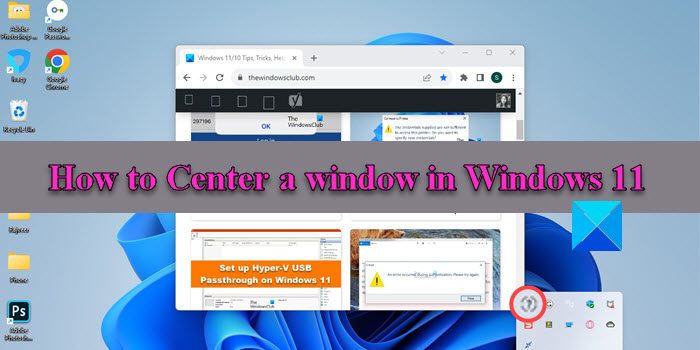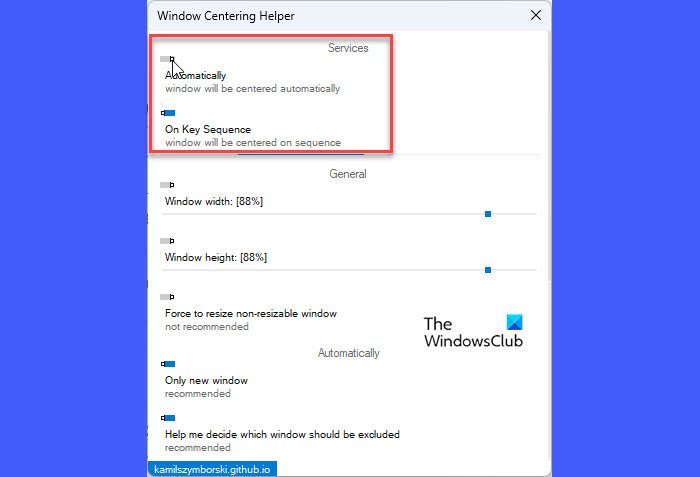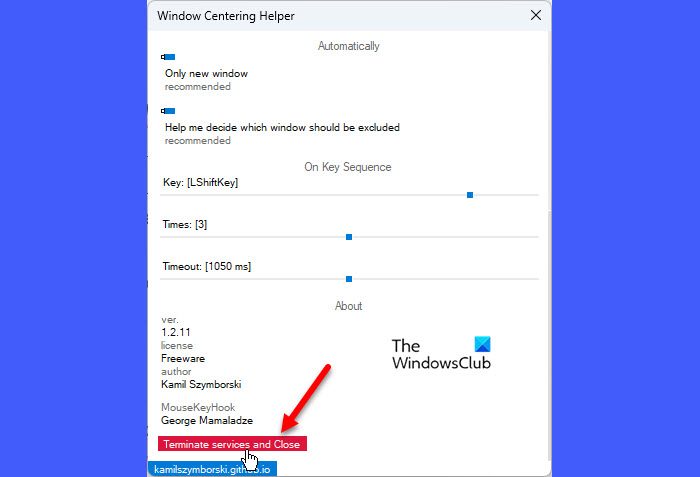In this post, we will show you how to center a window in Windows 11 using Window Centering Helper. Windows Centering Helper is a simple and lightweight freeware that allows users to center all desktop windows (including pop-ups) automatically or manually through keyboard shortcuts. It neatly aligns program windows to the middle of the working area and helps keep their desktops tidy and organized.

Windows Centering Helper is a minimalistic software that stays in the system tray area and doesn’t trouble the user. In this post, we will examine it and explain how it helps keep the open program windows centered on a Windows 11/10 PC.
How to Center a window in Windows 11
To center a window in Windows 11 using Windows Centering Helper, you need to first download the software from its official GitHub page. The download is available in portable and installer versions. The portable version runs with a double-click, while the installer version requires an installation before the application can be launched.
The application requires .NetFramework 4.5 and runs in the system tray, so when you launch it, you will have to click on its icon in the system tray area to open its minimalistic control panel.

The panel shows settings that are applicable by default. There’s an ON/OFF toggle above each setting (in the left corner) that allows you to control how the app works on your system.
Center a window using Windows Centering Helper
As mentioned, the app allows centering program windows either automatically or using a hotkey. By default, both of these settings are ON (both services are running in the background). So when you open any program, it will, by default, open aligned to the center of your desktop. When you open another program, it will also get aligned to the center, on top of the previous program window.
If you want to manually center a window, you can switch off the toggle next to the ‘Automatically‘ setting.

Now you have the ‘On Key Sequence‘ toggle ON. So whenever you open a new program window, it will not align to the center of the desktop until you press the left Shift key 3 times in a row. This is the default key sequence to instantly move a window in the middle of the screen. However, if you didn’t get the idea of repeatedly pressing the Shift key, you can modify the key sequence from the app’s settings.
Windows Centering Helper Settings
To change this key sequence, scroll down (on the application’s control panel) to the ‘On Key Sequence‘ section. You will see three settings. Each setting will have a slider next to it for changing its value.
- Key: Use this slider to change the ‘key’ in the key sequence from the left Shift key to something else (Back, PageUp, F1, F2, etc.)
- Times: Use this slider to change the number of times the key needs to be pressed to activate the command.
- Timeout: Use this slider to set the timeout between 100-2000 ms.
Apart from the above settings, the application’s control panel shows a few other setting options under the General and the Automatically sections.
The ‘General’ section shows settings to control the size of the window while it is being centered (window width, window height, force resize the non-resizable window), whereas the ‘Automatically’ section shows settings that let you decide whether to center only new widow and which window to exclude from being centered automatically.
Exiting Windows Centering Helper

To close the application, scroll down to the bottom of the application window and click on the Terminate services and Close button (highlighted in red color).
I hope you find this tool useful.
Read: How to disable Notification and Action Center in Windows.
How do you move a window to the center in Windows 11?
You may use the drag-and-drop method to center a window in Windows 11. Click and hold the title bar of the window and drag it to the center of your desktop screen. Release the mouse button to drop the window in the center. When you open that window again, it will revert to the shape and location you last left it in.
How do I resize a window in Windows 11?
You can resize a window in Windows 11 using various methods. The easiest is using the mouse. Move your mouse pointer to a corner of the window. When it turns into a two-headed arrow, click and drag the cursor in an outward or inward direction to resize the window. You can also use the Maximize or Restore buttons in the title bar of the window to resize a window to fit the entire screen and then restore it back to the previous size. The Snap Layouts feature also allows you to effortlessly resize and organize windows in Windows 11.
Read Next: How to move a window that is off-screen in Windows.
Leave a Reply